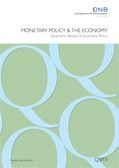Monetary Policy and the Economy Q1/16
 OeNB
OeNB
- Erschienen:
- April 2016.
 OeNB
OeNB
Call for applications: Visiting Research Program (PDF, 1,4 MB) en 27.04.2016, 00:00:00
Austrian economy fueled by growth stimuli, yet fraught with external risks (PDF, 1,6 MB) Fenz, Rumler. Fenz, Rumler – Monetary Policy and the Economy Q1/16 en 27.04.2016, 00:00:00
Saving, portfolio and loan decisions of households when interest rates are very low – survey evidence for Austrian households
(PDF, 1,6 MB)
Beer, Gnan, Ritzberger-Grünwald.
Do Austrian households adapt their savings and loan decisions in an ultra-low interest rate environment? To answer this question, we analyzed a special OeNB barometer survey conducted in spring 2015 that allows us to assess household interest rate perceptions as well as their impact on saving, portfolio allocation and borrowing decisions.
Overall, we find that the very low interest rates were only one of several determinants in savings and loan decisions and have had only a small effect so far. The impact of the ultra-low interest rate environment on portfolio choice is also quite limited. Households that did adapt their portfolio often showed a stronger preference for savings with savings and loan associations than for other options. Furthermore, we observe a shift to real assets. Portfolio rebalancing into riskier assets is not widespread.
Many households at the time of the survey considered circumstances relatively favorable for taking out loans. However, this does not imply that loan demand increased strongly, as borrowing decisions are also affected by other, potentially more important determinants. If they were faced with higher loan installments, most households would cut consumption expenditures.
The survey results may be useful in assessing e.g. the effectiveness of monetary policy. The modest impact of ultra-low interest rates on savings and portfolio rebalancing into riskier assets suggests that ultra-low interest rates have a limited ability to stimulate aggregate demand through the risk-taking and portfolio rebalancing channels, at least in the case of households in Austria.
en
household finance, low interest rates, savings and loan decisions
D12, D14
27.04.2016, 00:00:00
The Stability and Growth Pact since 2011: More complex – but also stricter and less procyclical? (PDF, 1,7 MB) Prammer, Reiss. The European fiscal framework has been extensively reformed since 2011. Nevertheless, it is consistently criticized for its procyclicality, its complexity and its large consolidation requirements. We provide a general overview of European fiscal rules. Then we argue that while recent reforms have undoubtedly made the Stability and Growth Pact more complex, one cannot make such a general statement concerning its procyclicality and its strictness. The preventive arm of the SGP has been made both stricter and less procyclical, while the newly introduced debt benchmark is not only very complex, but also more procyclical than the rest of the SGP. Furthermore, the effect on the procyclicality of Excessive Deficit Procedures is ambivalent; procyclicality was increased by the introduction of intermediate headline targets, but also decreased via new effective action indicators. en Stability and Growth Pact, fiscal rules, fiscal policy E61, E62, H60 27.04.2016, 00:00:00